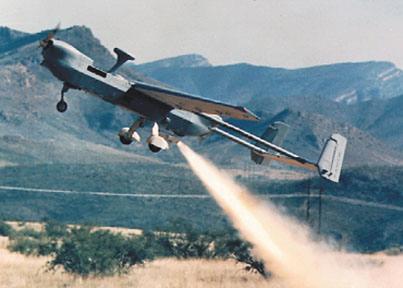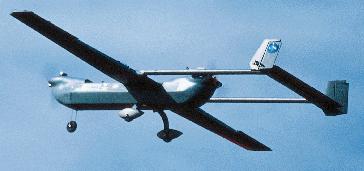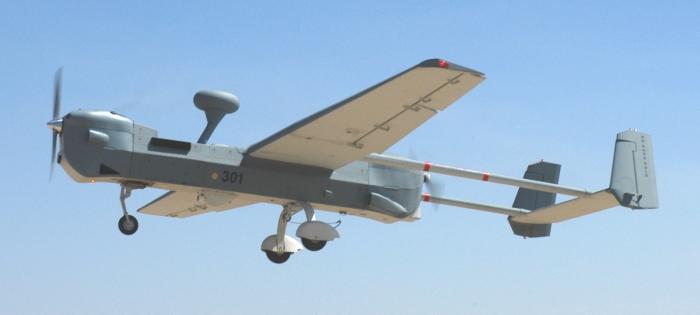Northrop Grumman (TRW/IAI) BQM-155/RQ-5/MQ-5 Hunter
In the late 1980s, the U.S. Army and U.S. Navy formulated several requirements for different types of UAVs. One of these was for a battlefield surveillance and target acquistion UAV, named UAV-SR (Unmanned Aerial Vehicle - Short Range). In 1989, two designs were chosen for the final UAV-SR competition, the McDonnell Douglas Sky Owl, and the TRW/IAI Hunter. The designations YPQM-149A and YPQM-150A were reserved for the UAV-SR competitors, but the only available public documentation (source [2]) seems to indicate that it was possibly never established, which number should apply to which design.
The Hunter, originally known as JIMPACS (Joint Improved Multimission Payload Aerial Surveillance, Combat Survivable), was based on the Israel Aircraft Industries (IAI) Impact UAV. TRW provided systems integration and management of the Hunter in the USA. In March 1991, the evaluation of Sky Owl and Hunter began. The tests included "relay flights", in which one vehicle would relay the signals between the ground and another vehicle, which was flying the actual mission. In June 1992, the Hunter was declared the winner of the UAV-SR competition, and in February 1993, TRW received a contract for seven complete Hunter systems, with an average of eight vehicles per system. None of the reserved PQM-149 and PQM-150 designations was used, however, and Hunter became the BQM-155A instead.
 |
| Photo: TRW |
| BQM-155A (RQ-5A) |
The BQM-155A is powered by two Moto Guzzi two-cylinder piston engines. It takes off from normal runways, but booster-assisted zero-length launches are also possible. The major payload items are a combined TV/FLIR (Forward Looking Infrared) sensor, and a data relay system. Mission radius for single vehicle flights is about 150 km (80 nm), which can be extended to 300 km (160 nm) using a second Hunter as airborne relay. Maximum endurance is about 12 hours. The BQM-155A can fly autonomous preprogrammed missions, but can also be controlled from the ground station. The UAV lands like a conventional aircraft (it can optionally use its retractable hook to engage arrestor wires), but a parachute system is available for emergencies.
The first production BQM-155A flew in February 1994, and all systems had been delivered by September 1995. However, operational evaluation did not go all well, and several Hunters were lost in crashes. Funding for the DOD's various UAV programs was also insufficient, and therefore the operational Hunter program was officially terminated in January 1996, after a total of 56 UAVs had been delivered. Most of the remaining air vehicles and ground systems were put in storage, with only a few remaining active for further testing.
 |
| Photo: TRW |
| BQM-155A (RQ-5A) |
In 1999, some Hunters were taken out of storage for operational use in the operation in the Kosovo. At that time, the BQM-155A was redesignated as RQ-5A (in the new Q-for-UAV series in the designation system for manned aircraft), and several RQ-5As were equipped with a laser designator. The remaining Hunter systems of the U.S. Army were used for test and evaluation purposes, and were planned to be retired when the new RQ-7 Shadow 200 became available. However, initial delays in the RQ-7 program and later the growing importance of UAVs have lead to a marked increase of the Army's use of their RQ-5A systems.
Beginning in January 2003, Northrop Grumman developed a repackaged version of their BAT (Brilliant Anti-Tank) guided anti-armour submunition, which can be deployed by suitably modified Hunters. The first modified BATs and Hunters were delivered to the U.S. Army in March 2003, and in April 2005 the designation MQ-5A was allocated to RQ-5As modified for weapons delivery.
In 2003, Northrop Grumman purchased the Hunter program from TRW. Subsequently, the company developed the MQ-5B, a Hunter variant which has been further optimized for the multi-mission role. It first flew in July 2005. The MQ-5B has a longer center-wing section, increasing the span by about 1.5 m (5 ft). This ensures proper clearance of the landing gear when dropping the BAT weapon. Additionally, the longer wing provides for a higher ceiling, and holds more fuel for increased endurance. The MQ-5B is also fitted with improved avionics and Mercedes Benz heavy-fuel engines. The U.S. Army has ordered 18 MQ-5B aircraft, which are expected to remain in service until at least 2009.
 |
| Photo: Northrop Grumman |
| MQ-5B |
Northrop Grumman has also developed a modified version of BAT called Viper Strike. This guided bomb replaces the BAT's acoustic/infrared seeker system with a laser seeker, making the Viper Strike a precision guided weapon suitable for urban combat. By early 2005, two MQ-5A Hunters and about a dozen Viper Strike munitions were deployed for combat operations in Iraq. Further optimizations of the Hunter/Viper Strike system are under development.
Specifications
Note: Data given by several sources show slight variations. Figures given below may therefore be inaccurate!
Data for RQ-5A (BQM-155A), MQ-5B:
| RQ-5A | MQ-5B | |
|---|---|---|
| Length | 6.95 m (22 ft 9.6 in) | 7.01 m (23 ft) |
| Wingspan | 8.90 m (29 ft 2.4 in) | 10.44 m (34 ft 3 in) |
| Height | 1.65 m (5 ft 5 in) | ? |
| Weight | 725 kg (1600 lb) | 820 kg (1800 lb) |
| Speed | 196 km/h (106 knots); loiter speed 165 km/h (89 knots) | |
| Ceiling | 4570 m (15000 ft) | 5490 m (18000 ft) |
| Mission Radius | 150 km (80 nm); 300 km (160 nm) for relay-flights | |
| Endurance | 12 h | 18 h |
| Propulsion | 2x Moto Guzzi two-cylinder piston engine; 47.7 kW (64 hp) | 2x Mercedes Benz piston engine |
Main Sources
[1] Kenneth Munson (ed.): "Jane's Unmanned Aerial Vehicles and Targets, Issue 15", Jane's, 2000
[2] Department of Defense Missile Nomenclature Records
[3] "Unmanned Aircraft Systems Roadmap, 2005-2030", Office of the Secretary of Defense, August 2005
[4] Northrop Grumman Website
Back to Current Designations Of U.S. Unmanned Military Aerospace Vehicles
Back to
Directory of U.S. Military Rockets and Missiles
Last Updated: 14 October 2005